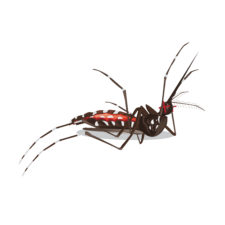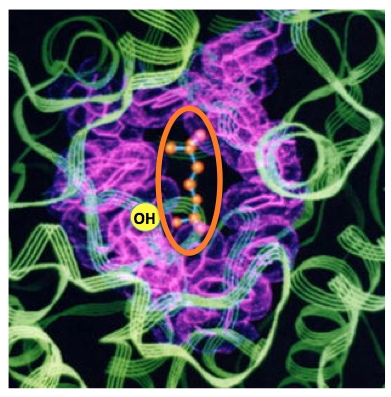 A (very) dead mosquito. Photo: Shutterstock
A (very) dead mosquito. Photo: Shutterstock
Most of the time when there is a chemical scare in the news, it turns out to be a whole lot of noise about nothing. The list is long: traces of formaldehyde in shampoo, miniscule amounts of chemicals that are used to make plastics, preservatives, and aspartame. This list, which seems to grow every time you turn your head, also includes the insecticide phenothrin (Anvil), which is, in fact, so safe that you can eat it (1).
But, right now in Florida, they cannot afford to take chances. Not when there are at least 20 mosquito transmitted Zika infections in one small area of Miami, and maybe even a case in Palm Beach—70 miles away. Fortunately, they are not fooling around.
Health officials brought out the big guns—organophosphates. One of them is Naled, and it is far from harmless. It is a pretty good poison, which works by short-circuiting nervous systems of mosquitoes, and just about everything else that is alive (2). Here's how it works:

Picture a nerve as a long wire with a large number of tiny gaps in it. These gaps are called synapses, and when they are empty, no current can flow. But when there is something to fill the gap (just like an on-off light switch), current can flow and the nerve fires.
In nerves, the switches are chemicals, which are called neurotransmitters. The on-off process is governed by simple biochemistry within the synapse. But, chemistry can also disable the mechanism that keeps the nerve from firing all the time—something you do not want to have happen to you. Nor do the mosquitoes.
The diagram above gives a simplified picture of the process:
- The end of the synapse that is closest to the source of stimulation is called the presynaptic terminal. This is one side of the switch.
- The presynaptic terminal receives a signal from part of the nerve behind it and releases a neurotransmitter into the synaptic cleft.
- Once in the cleft, the neurotransmitter attaches itself to receptors on the postsynaptic terminal—the other side of the switch.
- This makes the nerve fire, sending a signal along the next section of the nerve.
- The signal reaches the next synapse, which releases more neurotransmitter.
- Repeat many times.
- Then, there has to be a way for the neurotransmitter to be removed so the switch can continue to turn on and off.
If that last step does not take place, then the neurotransmitter stays in the synapse. Then, bad things happen (3).
This is why organophosphates are poisonous, and also why they are effective insecticides (4). Organophosphates shut down acetylcholinesterase—the enzyme that deactivates the neurotransmitter acetylcholine. If acetylcholinesterase isn't working properly, the nerve keeps firing, and all kinds of bad things happen. Here are a few: vomiting, diarrhea, seizures, paralysis, coma, and death.
And, this is all caused by messing with a single hydroxyl (OH) group, which is a tiny, but critical portion (the "business end") of acetylcholinesterase. (Enzymes are proteins, which are made up of amino acids. The hydroxyl group in question is a part of the amino acid serine.)
The graphic below shows how this works. The hydroxyl group (yellow circle with the OH inside) has one job—to catalyze (promote) the reaction that chemically breaks down (inactivates) the acetylcholine. Note that the acetylcholine (orange oval) is sitting in just the right position so that the hydroxyl group (yellow circle) can reach it. The distance between the two is critical.

This simple reaction (also called ester hydrolysis) is responsible for the inactivation step that turns the switch from on to off, by degrading acetylcholine. If the hydroxyl group of acetylcholinesterase is tied up and not available to do its normal job, then the enzyme cannot function, and the synapse will remain full of acetylcholine. The off switch won't work.
What ties the hydroxyl group up? Organophosphates sure can. This is why they are potent neurotoxins— because of the love affair between phosphorus and oxygen. Those bad boys really like to hang out together (5). 
Deactivation of acetylcholinesterase by an organophosphate. New bond is shown in red.
Once Naled "finds" the acetylcholinesterase, a "coupling" takes place between the two atoms in the green circles. The phosphorous atom in Naled reacts with, and forms a chemical bond with, the hydroxyl group of the acetylcholinesterase. (The new bond is shown in red.) And it doesn't let go. The enzyme is now altered such that it no longer has the required hydroxyl group . No free hydroxyl = no breakdown. No breakdown = death. One very simple chemical reaction that screws up an entire neurological pathway.
Pretty cool chemistry, and it's smart that Florida public health officials have not caved into environmentalists and forced people to buy citronella candles or bracelets with essentials oils, and are using something that actually works.
There are times where there are simply no great choices. This is one of them. Naled is more toxic than other mosquito sprays, but given what is now going on with Zika in Puerto Rico (6) allowing the virus to spread in Florida is worse. This is no time to fool around.
Notes:
(1) Anvil (phenothrin), which is commonly used to kill adult mosquitoes, has such a good safety profile that it is not even possible to find a lethal dose in rats. The chemical is less toxic to humans than everyday drugs and chemicals. This is not true for cats. They unusually susceptible to Anvil toxicity.
(2) Although Naled is toxic to both insects and mammals, it takes far less to kill insects. This is why it can be used (carefully) around people. Toxicity is directly related to dose.
(3) Inhibition of the removal of the neurotransmitter from synapses can be beneficial as well. The class of antidepressants called SSRIs are thought to work by blocking the reabsorption of serotonin into the presynaptic terminal, thus increasing serotonin levels in the brain. Reabsorption is a different method that is used by the body to clear the synaptic cleft.
(4) The chemical weapons Sarin and VX gas work in an identical way. But they are far more poisonous than Naled.
(5) This is less scientific way of saying that phosphorous-oxygen bonds are strong.
(6) It was recently estimated that one-quarter of Puerto Rico could become infected.



